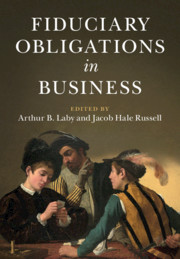Book contents
- Fiduciary Obligations in Business
- Fiduciary Obligations in Business
- Copyright page
- Dedication
- Contents
- Contributors
- Editors’ Acknowledgments
- Introduction The Decline and Rise of Fiduciary Obligations in Business
- Part I Identifying Fiduciaries and Their Duties
- 1 Fiduciary Duties on the Temporal Edges of Agency Relationships
- 2 Extra Large Partnerships
- 3 The Three Fiduciaries of Delaware Corporate Law—and Eisenberg’s Error
- 4 Trust, Discretion, and ERISA Fiduciary Status
- 5 Examining Indenture Trustee Duties
- Part II Gaps and Alternatives in Fiduciary Regimes
- Part III Historical and Comparative Perspectives
- Part IV Stakeholders and Society
- Index
4 - Trust, Discretion, and ERISA Fiduciary Status
from Part I - Identifying Fiduciaries and Their Duties
Published online by Cambridge University Press: 20 August 2021
- Fiduciary Obligations in Business
- Fiduciary Obligations in Business
- Copyright page
- Dedication
- Contents
- Contributors
- Editors’ Acknowledgments
- Introduction The Decline and Rise of Fiduciary Obligations in Business
- Part I Identifying Fiduciaries and Their Duties
- 1 Fiduciary Duties on the Temporal Edges of Agency Relationships
- 2 Extra Large Partnerships
- 3 The Three Fiduciaries of Delaware Corporate Law—and Eisenberg’s Error
- 4 Trust, Discretion, and ERISA Fiduciary Status
- 5 Examining Indenture Trustee Duties
- Part II Gaps and Alternatives in Fiduciary Regimes
- Part III Historical and Comparative Perspectives
- Part IV Stakeholders and Society
- Index
Summary
Debates over fiduciary status gained national prominence with the Department of Labor’s 2016 attempt to define an investment adviser fiduciary under the Employee Retirement Income Security Act in 2016. The DOL’s fiduciary rule, however, was vacated by the courts, leaving doubt as to whether and when an investment advisor is considered a fiduciary under ERISA. Moreover, many believe that earlier guidance from the DOL on who is an investment advisor fiduciary is too narrow to protect retirement investors. What is less well known is that many of the debates in ERISA over investment advisor fiduciaries track larger debates in the common law regarding fiduciary status. This chapter explores three parallels between the common law and ERISA in determining fiduciary status. The first is the structure of fiduciary categories and the division between categorical and ad hoc fiduciaries. The second is the tendency to look to whether one person has discretionary authority to determine whether the first person is a fiduciary. The third is the challenge raised by advice giving. Both common law courts and ERISA jurisprudence struggle to determine whether and when advisors, who lack discretionary authority, should be considered fiduciaries. The chapter concludes that trust can serve as a foundation for an advisor’s fiduciary status both in the common law and under ERISA.
Keywords
- Type
- Chapter
- Information
- Fiduciary Obligations in Business , pp. 74 - 92Publisher: Cambridge University PressPrint publication year: 2021



